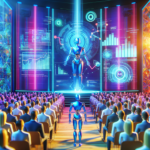Nvidia’s Cosmos-Transfer1 Revolutionizes Realistic Robot Training Simulations
Nvidia has introduced Cosmos-Transfer1, a groundbreaking AI model designed to bridge the gap between simulated training environments and real-world applications for robots and autonomous vehicles, enabling highly effective realistic robot training simulations.
Adaptive Multimodal Control in Cosmos-Transfer1
Cosmos-Transfer1 is a conditional world generation model that utilizes multiple spatial control inputs across various modalities, such as segmentation maps, depth maps, and edge maps. This allows for highly controllable and customizable world generation, making it particularly useful for Sim2Real applications. The model’s adaptive multimodal control system enables developers to weight different visual inputs differently across various parts of a scene, significantly improving the realism and utility of generated environments.
Transforming AI Simulation Technology
Traditional approaches to training physical AI systems often involve collecting massive amounts of real-world data, which is costly and time-consuming, or using simulated environments that lack real-world complexity and variability. Cosmos-Transfer1 addresses this dilemma by allowing developers to generate photorealistic simulations that preserve crucial aspects of the original scene while adding natural variations. This capability is especially valuable in robotics, where precise control over robotic movements is essential, and in autonomous vehicles, where preserving road layouts and traffic patterns while varying environmental conditions is critical.
Physical AI Applications and Benefits
Cosmos-Transfer1 can be post-trained into policy models to generate actions, saving the cost, time, and data needs of manual policy training. Here are some key benefits and applications:
- Enhanced Training for Robots: Cosmos-Transfer1 enhances photorealism and preserves physical dynamics, making it ideal for training humanoid robots and industrial machines in complex tasks like warehouse logistics and assembly-line operations.
- Autonomous Vehicle Development: For autonomous vehicles, it enables developers to maximize the utility of real-world edge cases, helping vehicles learn to handle rare but critical situations without needing to encounter them on actual roads.
- Scalable Synthetic Data: The model generates scalable, photorealistic synthetic data that aligns with real-world physics, ensuring AI agents generalize effectively from simulation to real-world deployment.
Nvidia’s Strategic AI Ecosystem
Cosmos-Transfer1 is part of Nvidia’s broader Cosmos platform, a suite of world foundation models designed specifically for physical AI development. The platform includes models like Cosmos-Predict1 for general-purpose world generation and Cosmos-Reason1 for physical common sense reasoning. Nvidia’s decision to publish both the Cosmos-Transfer1 model and its underlying code on GitHub democratizes access to advanced simulation technology, allowing smaller teams and independent researchers to accelerate progress in physical AI development.
Real-Time Generation and Hardware Performance
Nvidia demonstrated Cosmos-Transfer1 running in real-time on its latest hardware, achieving a significant speedup when scaling from one to 64 GPUs. This performance enables the generation of high-quality video in real-time, addressing another critical industry challenge: simulation speed. Here are the key points:
- Real-Time Simulations: Fast, realistic simulation allows for more rapid testing and iteration cycles, accelerating the development of autonomous systems.
- Hardware Efficiency: The model leverages Nvidia’s powerful hardware to generate photorealistic simulations quickly, making it a valuable tool for developers working on tight deadlines.
Open-Source Innovation and Developer Access
By making Cosmos-Transfer1 available on Hugging Face and GitHub, Nvidia removes barriers for developers worldwide. Here’s how this benefits the community:
- Global Access: This public release gives access to simulation technology that previously required substantial resources, fitting into Nvidia’s broader strategy of building robust developer communities around its hardware and software offerings.
- Efficient Training Environments: For robotics and autonomous vehicle engineers, these tools could shorten development cycles by providing more efficient training environments, allowing systems to be exposed to a wider range of scenarios before real-world deployment.
Key Capabilities of Cosmos-Transfer1
- Generate Scalable, Photorealistic Synthetic Data: Aligns with real-world physics, ensuring AI agents generalize effectively from simulation to real-world deployment.
- Control Object Interactions and Scene Composition: Through structured multimodal inputs, developers can fine-tune scene generation, object placement, and motion dynamics.
- Adaptive Multimodal Control: Allows developers to weight different visual inputs differently, enhancing the realism and utility of generated environments.
By leveraging Cosmos-Transfer1, developers can create highly realistic and customizable simulations, revolutionizing the field of realistic robot training simulations and paving the way for more advanced and capable AI systems in robotics and autonomous vehicles.
Additional Resources:
NVIDIA Cosmos World Foundation Models for Physical AI
Nvidia’s Cosmos-Transfer1 for Realistic Robot Training
Understanding External Links in SEO




0 Comments